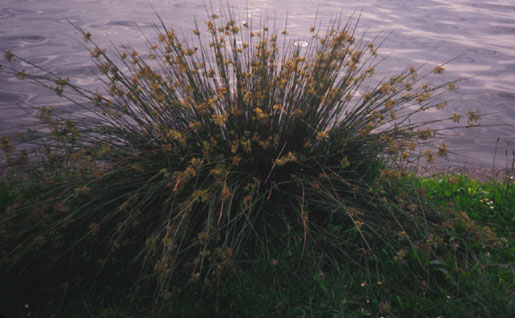
|
| Common Rush; Juncus effusus L. |
Rush Family; JUNCACEÆ
|
| Rushes grow in moist, wet or mucky soils, even if under water sometimes. Lowland property, by lakes for example, always has
several kinds of rushes. Even low dank spots in semi-shady gardens can give rise to weedy rushes. Three species are fairly common locally as
garden weeds in these conditions: Toad Rush (Juncus bufonius) is a wiry little weed often bronzy colored. Dagger-leaf Rush (J. ensifolius) is a diminutive iris-lookalike with wretched brown flowers. The Common, Hummock or Soft Rush, featured in this article, is
Juncus effusus (sometimes J. communis in old books). Other kinds, as well as sedges, reeds, bulrushes, swamp grasses and cattails, are mostly plants
of wild areas, not as likely to grow in heavy damp soils of backyards or garden beds. |
| The Common Rush grows throughout temperate areas of the Northern hemisphere, exhibiting variable size and vigor to suit
different conditions. The normal specimens seen locally are knee-high to, at most, just about six feet tall. Dense, tufted clumps of cylindrical, shining, smooth, green pith-filled stems make the plant. Uprooting one of these clumps entails major labor. The clump grows from a few slender short stems the first few years, to a massive tussock mound, arching gently, ten years later. |
| The stems are colored army-green year round, are pliable, flavorless, odorless, and elegantly tapered. Handling them, bending
and twisting them, is pleasant. Spongy pith within the green tube makes them easily rebound when squished between fingers. In June or
July the plant sends forth little pale brown affairs that are wind-pollinated flowers. These are borne near the top of some stems, and consist
of congested clusters of dozens of dainty individuals on threadlike stalks. The whole flower mass appears to erupt from the main stem
through a slit. Tiny seed capsules follow the flowers. It is details of seeds and the like that technically distinguish rushes from grasses, sedges,
and so forth. |
| In the Language of Flowers, the Rush officially represents "Docility." Why? Maybe because the limber stems are there
ever-ready to be used by people. The plant itself appears a perfect symbol of indomitability or stoicism. Unfaltering, it remains healthy and green
in mud, severe cold, blasting sunshine or dappled shadows, living on and on for who knows how long. |
| The Common Rush is much more than a mere inconvenient weed to some people. It is a plant whose virtues have proved useful
to both the needs of earlier civilizations and to the luxurious demands of our own time. |
| As food it is nothing for us, unlike many cattails, reeds and sedges. Nor is it worth making into a dye. Medicinally the Rush has
been used only to a trivial extent in Chinese traditional practice. Its value, then, is as a fiber, a candle, and as an ornamental. The fibrous
stems have been used both in Japanese floor mats (tatami) and in some rush-bottom chairs. Rush-lights are primitive candles made by
selecting the strongest, longest stems in summer or autumn, peeling off all but a narrow band of green rind, drying the peeled pith core, then
dipping it into liquefied fat or wax. Rush-lights can burn well over an hour. Perhaps nobody now still makes these candles, but centuries ago
probably most poorer Europeans used them. |
| The last use of Rush is as an "ornamental grass" for moist, shady spots in gardens, or even as a houseplant. The ordinary green
wild race is not so employed, but its cultivated varieties are several. Weirdest is the corkscrew version ('Spiralis'), a delight to caress. A
few colorful variegated kinds sport zebra stripes of intriguing beauty. |
This muck-tolerant evergreen perennial is worth knowing by name!
|
Originally published as the Seattle Tilth newsletter Weed of the Month in March 1991, along with an illustration drawn by Annie Figliola.
Back |
|
|

